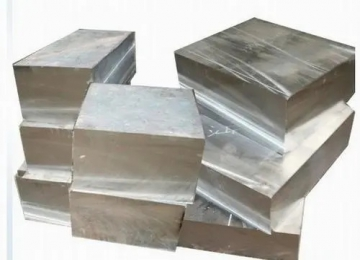
TC17 alloy is an α-β type two-phase titanium alloy rich in β-stabilizing elements. Its nominal composition is Ti-5Al-2Sn-2Zr-4Mn-4Cr. The alloy has a series of advantages such as high strength, good fracture toughness, high hardenability and wide forging temperature range, and can meet the needs of damage tolerance design and the requirements of high structural efficiency, high reliability and low manufacturing cost.
The main semi-finished products of this alloy are rods and forgings. Mainly used for manufacturing engine fans, compressor discs and large-section forgings. The matching of strength, plasticity and toughness can be adjusted through heat treatment, and various welding methods can be used for welding. The maximum operating temperature of TC17 alloy is 427°C.
Chemical composition of TC17 titanium alloy
Fe | C | Cr | Mo | N | Zr | Al | Sn | H | O | Ti: |
≦0.25 | ≦0.05 | 3.5-4.5 | 3.5-4.5 | ≦0.05 | 1.5-2.5 | 4.5-5.5 | 1.5-2.5 | ≦0.0125 | 0.08-0.13 | margin |
Heat treatment system of TC17 titanium alloy
The heat treatment system of titanium alloy usually includes the following steps:
1.Solid solution treatment: For β-forged materials, keep at 800℃±10℃ for 4 hours, and then water quench. For α+β forged materials, first keep it at 840℃±10℃ for 1 hour, then air-cool, then keep it at 800℃±10℃ for 4 hours, and finally water quenching.
2 Aging treatment: Choose an aging temperature within the range of 585-685°C. The typical aging system is to maintain it at 630°C for 8 hours and then air-cool.
3 Stress relief annealing: usually heated in the temperature range of 480-650℃ at a temperature not exceeding the aging temperature, kept for 1-4 hours, and then air-cooled or furnace-cooled. A typical stress relief annealing regime is 4 hours at 550°C, followed by air cooling. Stress relief annealing can be performed in an air furnace or vacuum furnace.
Smelting and casting process of TC17 titanium alloy
For the smelting and casting process of TC17 titanium alloy, three vacuum consumable electrode arc furnace melting is usually required.
This process can be briefly described as the following steps:
1 Prepare alloy materials: Prepare the raw materials and alloy formula required for TC17 titanium alloy.
2 Vacuum consumable electrode arc furnace melting: Smelting is carried out through vacuum consumable electrode arc furnace. This method is a commonly used titanium alloy smelting method that can provide high temperature and vacuum environment to ensure the purity and quality of the material.
3 Multiple meltings: In order to ensure the uniformity and purity of the alloy, multiple meltings are usually required.
Through this smelting process, TC17 titanium alloy can achieve the required composition and purity, providing high-quality raw materials for the subsequent casting process.
Corrosion resistance of TC17 titanium alloy
TC17 titanium alloy has excellent resistance to general corrosion, which is comparable to TA19 alloy. However, it may have some susceptibility to thermal salt stress corrosion. Therefore, this limiting factor needs to be considered when using TC17 alloy parts in hot salt stress corrosion environments.
In order to improve the thermal salt stress corrosion resistance of TC17 titanium alloy, the surface of the part can be anodized. Anodizing is a surface treatment method that improves the material’s corrosion resistance by forming an oxide layer on the surface of titanium alloys. This oxide layer can provide additional protection and reduce contact with corrosive media, thereby slowing or preventing the occurrence of hot salt stress corrosion.
It should be noted that anodizing treatment can not only improve the thermal salt stress corrosion resistance, but also improve the surface hardness and wear resistance of TC17 titanium alloy. Therefore, in specific application environments, for parts requiring higher corrosion performance, anodizing surface treatment can be considered to improve the performance of TC17 titanium alloy.
Application overview and special requirements of TC17 titanium alloy
TC17 titanium alloy is a titanium alloy widely used in the manufacturing field. It is especially suitable for manufacturing various engine fans, compressor discs and other parts.
The following is the application overview and special requirements of TC17 titanium alloy:
Application overview:
TC17 titanium alloy has a wide range of applications in the aerospace field, especially in engine manufacturing.
It is widely used in the manufacture of turbine engine fans, compressor discs and other key parts that require high temperature, high strength and high corrosion resistance.
special requirements:
TC17 titanium alloy has high strength, corrosion resistance and high temperature stability, and can withstand high mechanical and thermal stress in complex working environments.
When manufacturing TC17 alloy parts, the alloy composition and smelting process need to be strictly controlled to ensure high quality and consistency.
During the manufacturing process, special attention is paid to the heating and cooling control of the alloy to avoid excessively fast or uneven cooling processes that lead to inhomogeneities in the material structure and properties.
Our country has begun to develop and apply TC17 titanium alloy since the “Seventh Five-Year Plan”, and has achieved practical applications and breakthroughs in the field of aerospace engines.
The excellent performance and wide application of TC17 titanium alloy make it one of the materials that attract much attention in the aviation industry. Hope this information can meet your needs

